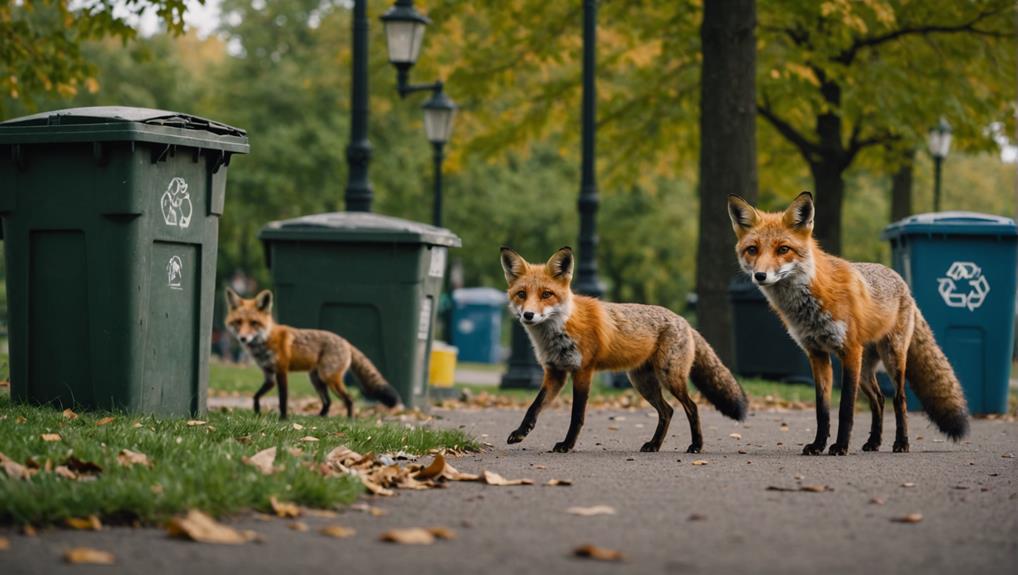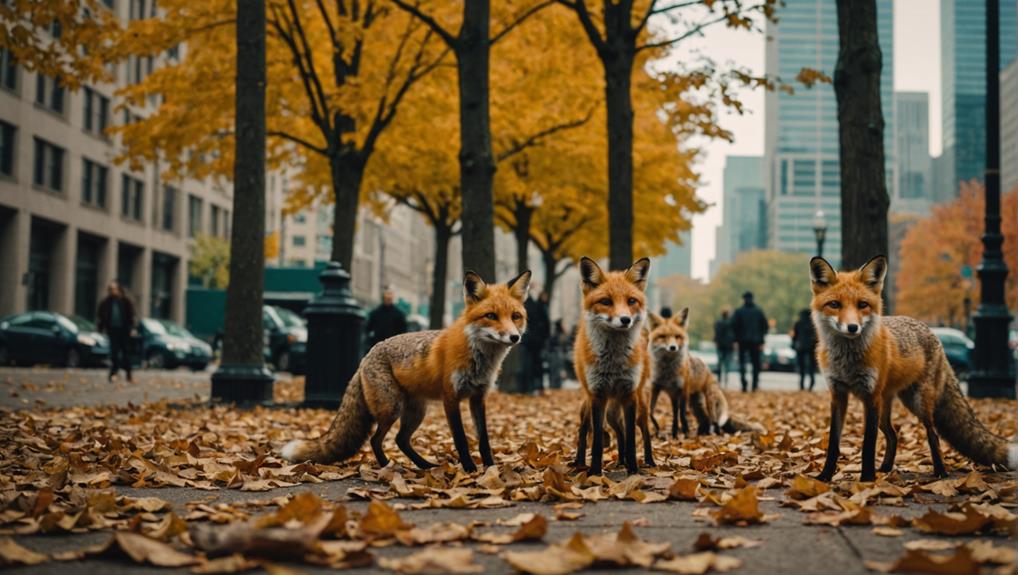Urban foxes are quite social, even in the bustling city! Typically, they hang out in small groups of 2 to 6 adults, meeting up a couple of times each night for some friendly chats and grooming sessions. They talk in a mix of barks and whines, communicating their moods and status within the group. Though they enjoy company, they also keep to their own turf, avoiding neighboring clans to prevent squabbles. Notably, in winter, they huddle together for warmth, proving that even foxes need a buddy. Stick around, and you'll uncover more delightful facts about these clever critters!
Contents
Social Structures of Urban Foxes
How do urban foxes navigate their social lives amidst the complexities of city environments? You might be surprised to learn that these clever canines have a fascinating social structure.
Urban foxes are often described as "facultatively social," meaning they can thrive alone but also form close-knit groups, especially during key moments like the breeding season. They exhibit strong social structures, with groups typically consisting of 2 to 6 adults, which enhances their teamwork and communication skills effective foraging techniques.
These foxes typically meet up about two times a night, engaging in friendly interactions more often than not. Think of it like a neighborhood gathering where everyone gets along—most of the time! However, they do have some territorial dynamics to contend with.
You'll find that members of neighboring groups prefer to avoid each other, keeping their connections strong within their own crew.
Interestingly, when winter rolls around, these social gatherings become even more frequent. It's as if they're all huddling together for warmth and support during the colder months.
The complexity of their social interactions affects their survival and reproduction, proving that there's much more to urban foxes than meets the eye.
Communication in Fox Groups
Urban foxes rely on a variety of communication methods to maintain their social bonds and navigate their complex interactions. These clever creatures utilize vocalizations like barks, whines, and throaty noises to express themselves, especially during encounters with neighboring groups.
Regular nightly gatherings among their social group help facilitate important communication through friendly greetings and grooming behaviors. In addition, urban foxes exhibit behavioral flexibility that allows them to adapt their communication styles based on different social contexts.
You might find it fascinating that:
- Intergroup meetings can be brief and sometimes a bit aggressive.
- Dominant and subordinate interactions within the group show a clear social hierarchy.
- Enthusiastic greetings often indicate familiarity, while some neighbors might get the cold shoulder.
In urban areas, where interactions with humans can be unpredictable, these vocalizations and behaviors play a vital role in their social dynamics.
Foxes learn to navigate their territories through these communication methods, allowing them to bond with their social group while keeping an eye on their rivals.
Territorial Behavior and Adaptation

Within social groups, you'll find a hierarchy. Dominant foxes tend to interact more frequently, ensuring their place at the top of the social ladder.
This social structure is further influenced by their adaptability to urban environments, as 70% of urban foxes thrive in cities, showcasing their ability to steer through complex social dynamics.
Seasonal changes can also shake things up. In winter, for instance, the urge to mate leads to more territorial disputes and fox meet-ups.
Understanding this complex territorial behavior is essential for estimating population sizes accurately. If you're not careful, those visitor dynamics can puff up the numbers like a balloon at a party!
Human Interactions With Urban Foxes
As foxes navigate their social hierarchies and territorial disputes, their interactions with humans become increasingly significant. Urban foxes often show a remarkable comfort around us. You might even catch sight of playful cubs frolicking in your garden!
When you feed these clever creatures, you can foster a bond that helps them recognize you as a friend. However, be mindful that this feeding can create a dependency on human-provided food.
Here are a few tips for responsible feeding:
- Scatter food to discourage territorial disputes among visiting foxes.
- Provide fresh water to benefit not just foxes, but all local wildlife.
- Set feeding times to help foxes establish a routine without relying solely on you.
Interestingly, a single garden can attract many foxes—one case reported 32 regular visitors!
While some worry that feeding might hinder their natural instincts, studies show that raised foxes maintain their independence once released.
By understanding and respecting these social groups, you can enjoy the delightful company of urban foxes while ensuring they remain self-sufficient in their urban landscape.
Challenges in Fox Social Dynamics

Steering through the complexities of fox social dynamics can be tricky, especially since these animals often forage alone. You might think this means they don't form strong social bonds, but that's not the case.
Foxes do meet regularly at rendezvous sites, where they can chat and catch up, fostering connections within their groups.
During the breeding season, the number of foxes you see interacting increases, but it's also when territorial disputes heat up between neighboring groups. You can almost picture it—foxes puffing up, looking fierce! With as many as 175 individual foxes identified in one study, estimating group sizes becomes quite the challenge.
Their overlapping territories and seasonal movements complicate how we see their social structure. Additionally, distinguishing between resident foxes and occasional visitors can muddle our understanding.
When visitors are included in group definitions, it can inflate population estimates, leading to confusion about the real dynamics. So, while foxes may seem solitary, their social lives are anything but simple.
Just like people, they navigate friendships, rivalries, and family ties, making their world a fascinating place to explore.
Final Thoughts
In the fascinating world of urban foxes, their social lives are more complex than you might think. Did you know that about 70% of urban foxes live in family groups? These clever critters communicate, mark their territory, and adapt to city life, all while dodging human interactions and challenges. It's a wild mix of survival and socializing! So next time you spot one, remember they're not just roaming—they're part of a lively community, maneuvering through the ups and downs of urban living.














